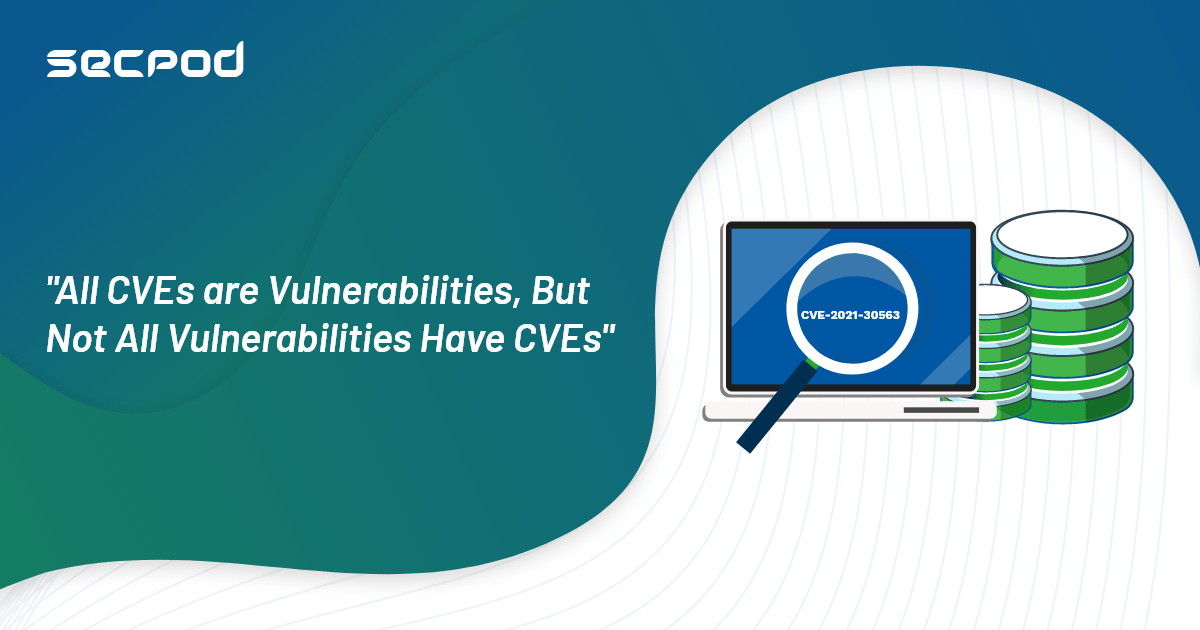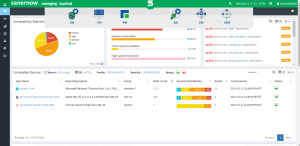CVE stands for Common Vulnerabilities and Exposures. It is the database of publicly disclosed information on security issues. All organizations use CVEs to identify and track the number of vulnerabilities. However, not all the vulnerabilities discovered have a CVE number. For instance, the CVE database reported 18,325 vulnerabilities in 2020. However, more than 40% of the vulnerabilities found in 2020 do not even have a CVE identifier assigned. The possible reason for this might be the vulnerabilities were old or never submitted for CVE assignment. This can be surpassed by using a Vulnerability Management tool.
In simple terms, we can state that ‘All CVEs are vulnerabilities, but not all vulnerabilities have CVEs.’
Managing vulnerabilities with CVE
Before we dwell in and see the importance of managing vulnerabilities beyond CVE, let us understand how to address vulnerabilities with CVE. With emerging vulnerabilities, CVEs play an essential role in the identification and detection of vulnerabilities. The primary purpose of CVEs is to standardize each vulnerability or exposure. It categorizes vulnerabilities in software and acts like a dictionary for organizations to enhance their security.
By using the CVE Ids for specific vulnerabilities, organizations can get CVE-compatible information. It allows security professionals to access information about a particular cyber threat. With this accurate information available on CVEs, security teams plan for remediation with vulnerability management software soon after detecting vulnerabilities.
CVEs are suitable for the organization to deal with vulnerabilities. But like most of the security tactics, it is not foolproof. As most of the vulnerabilities have no CVE number, those non-CVE vulnerabilities are often not given the attention they deserve.
How are vulnerabilities left unassigned without CVEs?
According to X-force data in 2020, the CVE-2019-19871 is the exploited vulnerability in Citrix Application Delivery Controller and Gateway. Despite this, there was a domination of ten more vulnerabilities by older security issues in Citrix applications. It clearly states that only two vulnerabilities had CVE numbers, and the rest were in crossfire. Likewise, many vulnerabilities tend to prevail in the network unnoticed without the vulnerability management tool.
This cumulation of unknown vulnerabilities increases the opportunity for attackers to exploit easily. Hence, it’s essential to identify and fix all vulnerabilities irrespective of CVE data as soon as possible.
Managing vulnerabilities without CVE
Vulnerability and CVE are interchangeable. Although, unique identifiers make it easy for security teams to know information about its vulnerability and state. Unfortunately, CVE systems can be misleading and do not cover all the vulnerabilities.
Many security teams still believe that it is enough to manage vulnerabilities with CVE data. This process might look simpler for identifying and remediating the vulnerabilities. But attackers are on the lookout for numerous sophisticated ways to exploit the network. Leaving CVE unassigned vulnerabilities to prevail in the network will only create new opportunities for attackers and open doors for wild security attacks.
To combat this challenge, you must opt for robust vulnerability management software to discover all types of vulnerabilities beyond CVE. The vulnerability management solution should have extensive scanning algorithms and integration with a comprehensive vulnerability database. This vulnerability database should be large and up-to-date with sufficient vulnerability details. The database should support all vulnerabilities irrespective of the CVE number.
Thus, the quality of the vulnerability database determines the accuracy of your vulnerability discovery and assessment. This reduces false positives and minimizes the attack surface of an organization.
What are the other critical vulnerabilities without CVEs?
In the previous sections of this article, we covered the importance of managing vulnerabilities with CVEs and without CVEs. However, the acronym CVE defines only the software vulnerabilities. Your network might possess a lot of security loopholes that may not be directly known as a vulnerability. These security loopholes are as strong as an identified vulnerability and will not have a standard CVE number.
Let’s understand what are other vulnerabilities prone in the network without CVEs.
- System misconfigurations
To breach an organization’s network, attackers will search for system misconfigurations. These are the assets running needless services or vulnerable settings like unchanging defaults. After an attempt to probe the environment, the misconfiguration systems are compromising.
- Weak credentials
A common tactic in use by attackers is the brute force method. It helps to guess organizations’ weak passwords. The weak passwords might also include default passwords. Such attacks gain access to a corporate network to various appliances. This leads to deletion, modification, and stealing data. In addition to this, attackers can install malware and gain greater access to systems.
- Unknown Assets
Without a proper inventory list of assets, it’s difficult to patch or manage them. For instance, in an organization with 10,000 assets, the unknown assets in the corporate network would be at least 2500. This is the basic vulnerability that every organization should take care of.
- Zero-day vulnerabilities
Zero-day vulnerabilities are software vulnerabilities known by attackers but not identified by the organization. It means that there is no available fix. This happens because the vulnerability is not reported to the system vendor. These are dangerous as there is no way to defend against them.
To effectively manage vulnerabilities and security loopholes, it is important to have a robust solution to keep all attack vectors at bay. There is a prime requirement of dealing with every vulnerability without standardization. An effective vulnerability management tool will ensure that you are addressing all high-risk vulnerabilities irrespective of CVE number.
SecPod SanerNow, for managing vulnerabilities above and beyond
SecPod Sanernow provides a full-fledged vulnerability management solution with closely-knit integrations with other cyberhygiene applications. Powered by the home-grown world’s largest security intelligence feed with more than 160,000 vulnerability checks, SanerNow manages all vulnerabilities beyond CVE details. The integrated patch management module ensures timely remediation and eliminates security gaps. Along with Vulnerability Management and Patch Management tools, SanerNow’s Security Risk and Compliance Suite comprises Compliance Management and Asset Management modules. These four applications integrated into one place tightens your security posture and combats cyberattacks.
It is high time you go beyond your traditional vulnerability management practices and implement a modern solution.
Schedule a demo and check out how SanerNow provides a modern solution for today’s complex security landscape.



